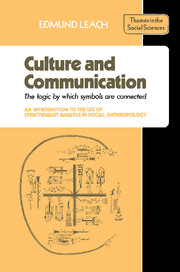 Culture and Communication
Culture and Communication Book contents
- Frontmatter
- Contents
- Culture and communication: the logic by which symbols are connected
- Introduction
- 1 Empiricists and rationalists: economic transactions and acts of communication
- 2 Problems of terminology
- 3 Objects, sense-images, concepts
- 4 Signals and indices
- 5 Transformations
- 6 Theories of magic and sorcery
- 7 The symbolic ordering of a man-made world: boundaries of social space and time
- 8 The material representation of abstract ideas: ritual condensation
- 9 Orchestral performance as a metaphor for ritual sequence
- 10 The physiological basis of sign/symbol sets
- 11 Mapping: time and space as reciprocal representations
- 12 Rank order and orientation
- 13 Examples of binary coding
- 14 Mating prescriptions and proscriptions
- 15 Logic and mytho-logic
- 16 Basic cosmology
- 17 Rites of transition (rites de passage)
- 18 The logic of sacrifice
- 19 Conclusion
- Bibliography
- Index
14 - Mating prescriptions and proscriptions
Published online by Cambridge University Press: 05 June 2012
- Frontmatter
- Contents
- Culture and communication: the logic by which symbols are connected
- Introduction
- 1 Empiricists and rationalists: economic transactions and acts of communication
- 2 Problems of terminology
- 3 Objects, sense-images, concepts
- 4 Signals and indices
- 5 Transformations
- 6 Theories of magic and sorcery
- 7 The symbolic ordering of a man-made world: boundaries of social space and time
- 8 The material representation of abstract ideas: ritual condensation
- 9 Orchestral performance as a metaphor for ritual sequence
- 10 The physiological basis of sign/symbol sets
- 11 Mapping: time and space as reciprocal representations
- 12 Rank order and orientation
- 13 Examples of binary coding
- 14 Mating prescriptions and proscriptions
- 15 Logic and mytho-logic
- 16 Basic cosmology
- 17 Rites of transition (rites de passage)
- 18 The logic of sacrifice
- 19 Conclusion
- Bibliography
- Index
Summary
Newcomers to the subject are often puzzled and bored by the enormous amount of space which the authors of social anthropological monographs devote to the detailed description and analysis of kinship terminologies and marriage rules. Most of the authors concerned would be hard put to it to justify what they do, but certainly the anthropological study of kinship, in this style, bears very directly on the theme of this essay.
In the first place both kinship terms and formal marriage rules constitute distinguishable ‘sets’ of metonymically related cultural itemslike the individual items of clothing which go to make up a particular costume. Furthermore, as we move across the ethnographic map, we often find that neighbouring communities of broadly similar culture adopt strikingly different conventions regarding the classification of kin. A semiotic structuralist style of analysis of the kind I have been describing suggests that in circumstances of this sort the overall pattern should be viewed as one of successive transformation rather than simple difference. Lévi-Strauss's celebrated The Elementary Structures of Kinshi (1949) was an attempt to apply this notion of transformation to a whole range of kinship systems stretching geographically from Australia to Northern Siberia! It was not altogether successful but the underlying idea remains important.
Secondly the concepts involved in kinship terms and marriage rules provide particularly tricky examples of the kinds of problem which were raised in Section 3, Notions such as ‘marriage’ and ‘fatherhood’ are, in the first instance, ‘ideas’ generated in the mind; they are not descriptive of any material objective ‘thing’ in the world out-there. Consequently the discussion of kinship categories and marriage rules is very easily converted into a kind of algebra.
- Type
- Chapter
- Information
- Culture and CommunicationThe Logic by which Symbols Are Connected. An Introduction to the Use of Structuralist Analysis in Social Anthropology, pp. 65 - 68Publisher: Cambridge University PressPrint publication year: 1976


